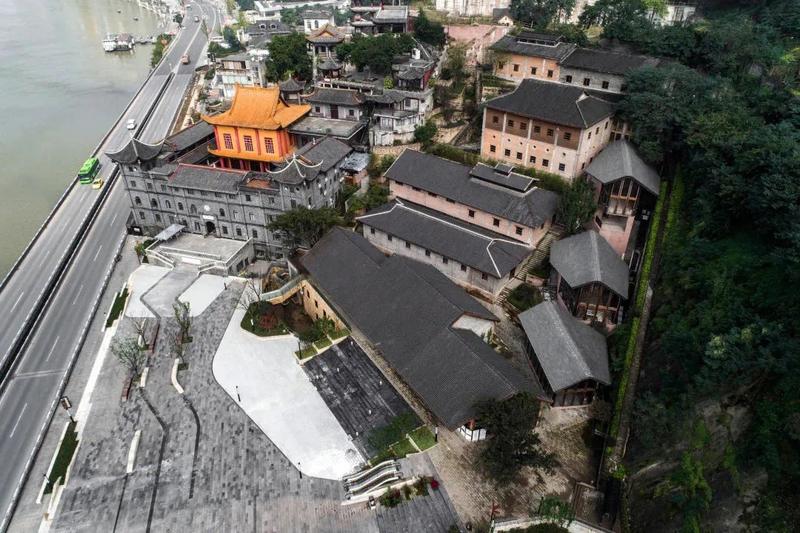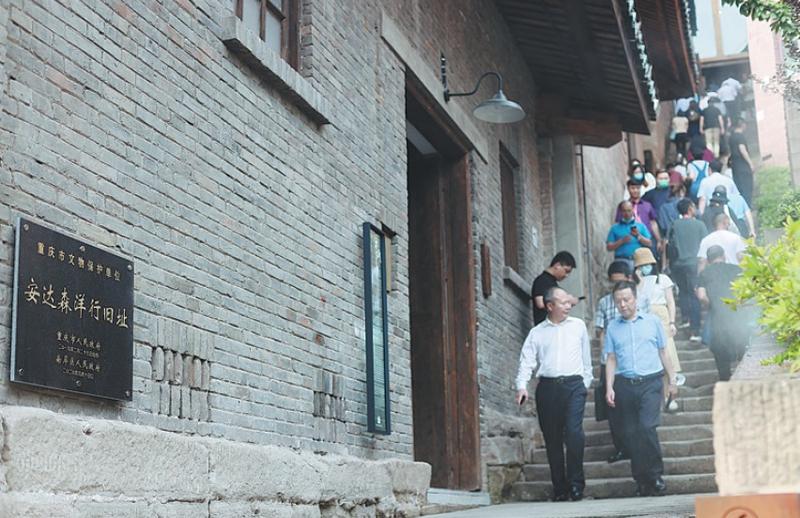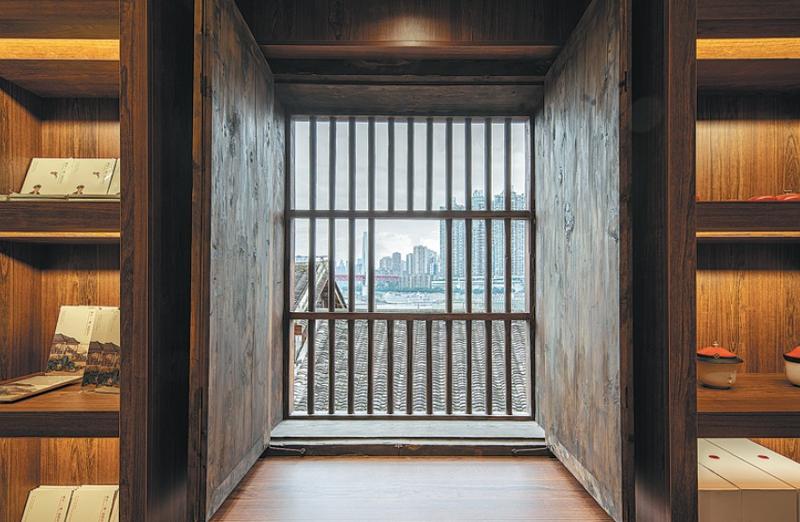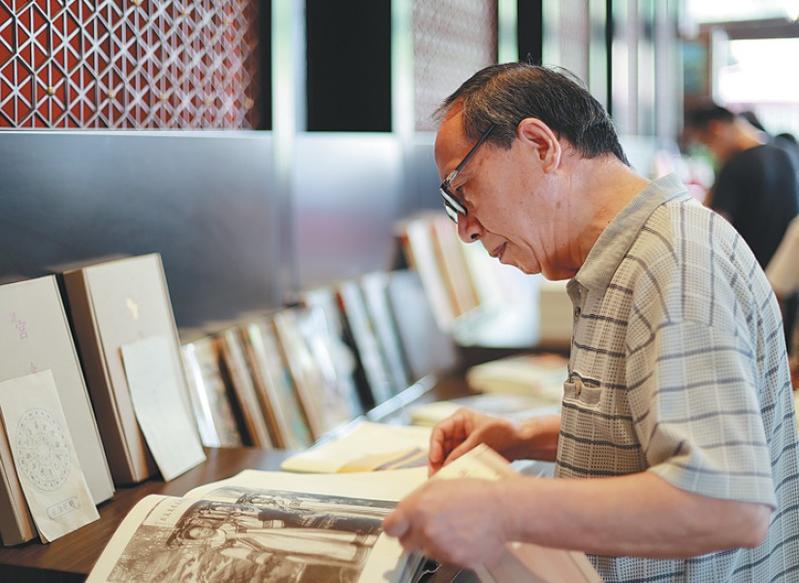A former trading house site in southwestern China, where precious cultural relics were saved from invaders, reopens as a museum, report Wang Kaihao in Beijing and Deng Rui in Chongqing.
 An aerial view of the compound of Anderson Firm which has been renovated into a memorial site. (PHOTO PROVIDED TO CHINA DAILY)
An aerial view of the compound of Anderson Firm which has been renovated into a memorial site. (PHOTO PROVIDED TO CHINA DAILY)
A set of warehouses in Chongqing on the southern bank of Yangtze River is 130 years old. In spite of its plain appearance, this former site of Anderson Firm, a Swedish trading house built in 1891, witnessed a gathering of precious cultural relics in the 1930s.
The compound of 2,500 square meters has a memorial hall that opened to the public on Friday on the eve of China's Cultural and Natural Heritage Day. Left unused for long, the house finally embraced its new life after a renovation from 2018 to 2020.
"This place once made a great contribution to protect our national treasures and inherit the lineage of Chinese civilization," says Xing Jun, deputy director of Chongqing Cultural Heritage Administration.
In 1933, when the War of Resistance Against Japanese Aggression (1931-45) was approaching Beijing, administrators of the Palace Museum decided to move key cultural relics housed there southward in case they fell into invaders' hands.
The museum, China's imperial palace from 1420 to 1911, also known as the Forbidden City, is home to myriad national treasures.
 The former compound of Anderson Firm is listed as a key historical site in Chongqing. (DENG RUI / CHINA DAILY)
The former compound of Anderson Firm is listed as a key historical site in Chongqing. (DENG RUI / CHINA DAILY)
The salvage campaign saw 13,492 boxes of cultural relics, including artifacts from the Summer Palace and Guozijian (the former imperial academy), embark on a journey to safety.
The relocation work lasted for a few years and the artifacts arrived in cities, including Shanghai and Nanjing in today's Jiangsu province.
However, when the war zone expanded to East China in 1937, they had to be shipped westward again along three routes. Consequently, 9,331 boxes of the cultural relics arrived in Chongqing that year through the middle route. They were secretly stored in three locations in the city, among which 3,694 boxes were put in four warehouses of Anderson Firm, according to Yan Hongbin, deputy director of the Palace Museum.
As Sweden was a neutral country in the war, the warehouses were not bombed in Japanese air raids.
Nevertheless, after bombing of Chongqing escalated in 1939, the artifacts were removed to Leshan, Sichuan province.
"Anderson Firm had finished its historical mission, but Chongqing people's emotion toward cultural relics of the Palace Museum remains deeply rooted," Xing says.
 The design of the renovated warehouses reflects local history and its link with the Forbidden City. (PHOTO PROVIDED TO CHINA DAILY)
The design of the renovated warehouses reflects local history and its link with the Forbidden City. (PHOTO PROVIDED TO CHINA DAILY)
The newly opened memorial hall in Chongqing is a cultural institution where local residents pay tribute to the relocation project of the artifacts during wartime.
The history of the project is elaborated in its gallery via displays as is the history of Chongqing since 1890, when the port city was first opened up for foreign trade. Anderson Firm was one of the earliest Western companies there.
After the war ended, all relocated relics were moved to Chongqing again before setting off on their journey home. Over 8,300 boxes later returned to the Forbidden City. About 2,200 boxes stayed in Nanjing, now part of a collection in Nanjing Museum, and the rest were taken to Taipei and remain there.
Incredibly, all 13,492 boxes escaped damage and were fully accounted for, according to Yan.
"In spite of going through the war, all the artifacts survived, safe and sound," Yan says. "It can be seen as a miracle.
"The memorial hall is a key venue to enable people to remember monumental moments of our wartime history, inherit traditional culture and prolong our country's psychological strength."
 Major exhibits at the site include replicas of the wooden boxes used in the relocation project of relics during wartime. (DENG RUI / CHINA DAILY)
Major exhibits at the site include replicas of the wooden boxes used in the relocation project of relics during wartime. (DENG RUI / CHINA DAILY)
In 2017, a research institute studying files concerning the southward relocation project was established in the Palace Museum.
The research was listed among key academic programs in social sciences with national-level funding in 2019.
The newly renovated architecture in Chongqing is expected to not only review the history, but also get closer to people's modern life. Perhaps, the dialogue between the new and the old can be reflected through the renovation.
The original craftsmanship and materials were upheld during the renovation of the four old warehouses. A cable-car track and the stone steps of Anderson Firm was also kept as key witness to history. However, the surrounding buildings were damaged and new steel frames and glass curtain walls were installed.
Such hybrid work made the memorial hall more interesting to visitors.
"The relics that were once relocated to the south also needed to 'go' beyond the courtyard of the Forbidden City," Xing says.
"The memorial hall in Chongqing can also be a venue to promote the awareness of protecting cultural heritage among the public."
 A visitor flips through a book on the history of the Qing Dynasty (1644-1911) at the site. (DENG RUI / CHINA DAILY)
A visitor flips through a book on the history of the Qing Dynasty (1644-1911) at the site. (DENG RUI / CHINA DAILY)
Consequently, a so-called Forbidden City classroom was set up in the memorial hall to host relevant education programs on cultural relics from the palace. Digitized exhibitions of more relics will be held at the hall in the near future.
A bookstore, cafe and post office in the Palace Museum theme have opened to connect history to people's daily life.
"To keep the dignity of our cultural heritage, the best way is not to enclose it or store it in an attic," says Shan Jixiang, director of Chinese Society of Cultural Relics. "We'd better usher it into people's real life, and make them a way to contribute to the dynamic development of our society."
The second Saturday of June is set as national Cultural and Natural Heritage Day. Chongqing was this year's main venue hosting events, including symposiums, lectures and special exhibitions.
Contact the writers through wangkaihao@chinadaily.com.cn



